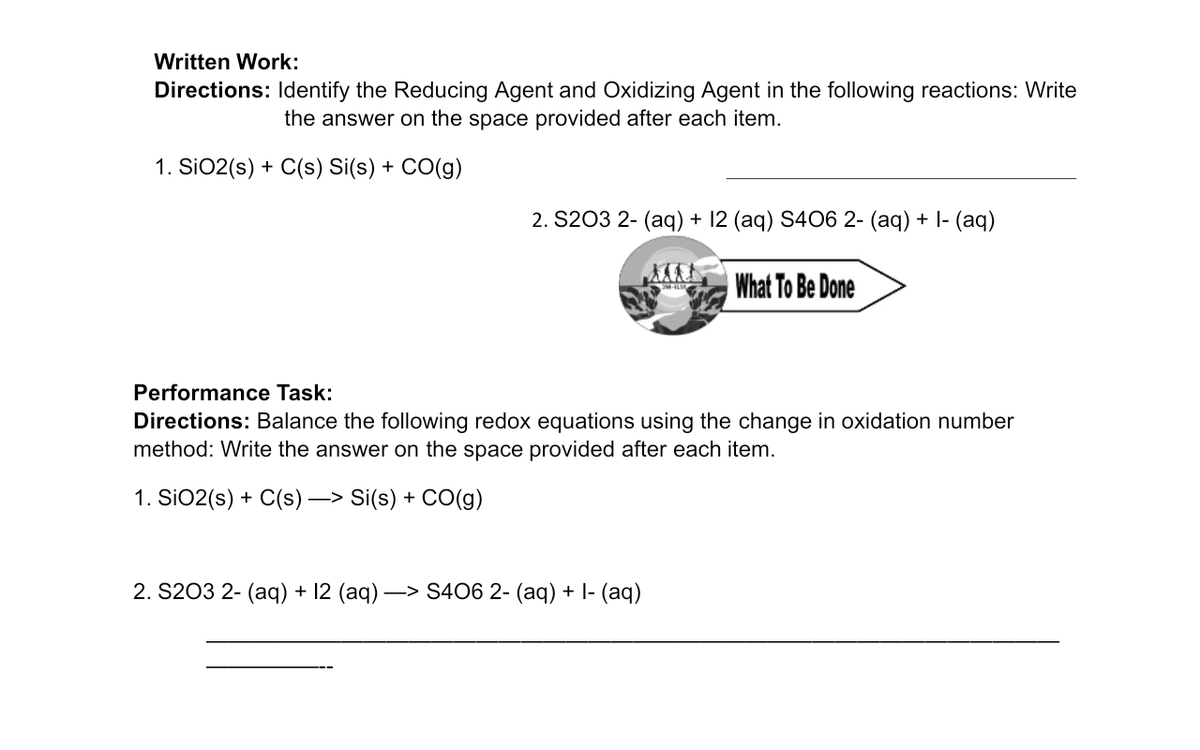Written Work: Directions: Identify the Reducing Agent and Oxidizing Agent in the following reactions: Write the answer on the space provided after each item. 1. SiO2(s) + C(s) Si(s) + CO(g) 2. S203 2- (aq) + 12 (aq) S406 2- (aq) + I- (aq) What To Be Done Performance Task: Directions: Balance the following redox equations using the change in oxidation number method: Write the answer on the space provided after each item. 1. SiO2(s) + C(s) –> Si(s) + CO(g) 2. S203 2- (aq) + 12 (aq) -> S406 2- (aq) + I- (aq)
Written Work: Directions: Identify the Reducing Agent and Oxidizing Agent in the following reactions: Write the answer on the space provided after each item. 1. SiO2(s) + C(s) Si(s) + CO(g) 2. S203 2- (aq) + 12 (aq) S406 2- (aq) + I- (aq) What To Be Done Performance Task: Directions: Balance the following redox equations using the change in oxidation number method: Write the answer on the space provided after each item. 1. SiO2(s) + C(s) –> Si(s) + CO(g) 2. S203 2- (aq) + 12 (aq) -> S406 2- (aq) + I- (aq)
Chemistry: The Molecular Science
5th Edition
ISBN:9781285199047
Author:John W. Moore, Conrad L. Stanitski
Publisher:John W. Moore, Conrad L. Stanitski
Chapter17: Electrochemistry And Its Applications
Section: Chapter Questions
Problem 33QRT: Consider these half-reactions: (a) Which is the weakest oxidizing agent? (b) Which is the strongest...
Related questions
Question

Transcribed Image Text:Written Work:
Directions: Identify the Reducing Agent and Oxidizing Agent in the following reactions: Write
the answer on the space provided after each item.
1. SiO2(s) + C(s) Si(s) + CO(g)
2. S203 2- (aq) + 12 (aq) S406 2- (aq) + I- (aq)
What To Be Done
Performance Task:
Directions: Balance the following redox equations using the change in oxidation number
method: Write the answer on the space provided after each item.
1. SiO2(s) + C(s) –> Si(s) + CO(g)
2. S203 2- (aq) + 12 (aq) -> S406 2- (aq) + I- (aq)
Expert Solution
This question has been solved!
Explore an expertly crafted, step-by-step solution for a thorough understanding of key concepts.
Step by step
Solved in 2 steps with 1 images

Knowledge Booster
Learn more about
Need a deep-dive on the concept behind this application? Look no further. Learn more about this topic, chemistry and related others by exploring similar questions and additional content below.Recommended textbooks for you

Chemistry: The Molecular Science
Chemistry
ISBN:
9781285199047
Author:
John W. Moore, Conrad L. Stanitski
Publisher:
Cengage Learning

Chemistry: Principles and Reactions
Chemistry
ISBN:
9781305079373
Author:
William L. Masterton, Cecile N. Hurley
Publisher:
Cengage Learning

Chemistry
Chemistry
ISBN:
9781305957404
Author:
Steven S. Zumdahl, Susan A. Zumdahl, Donald J. DeCoste
Publisher:
Cengage Learning

Chemistry: The Molecular Science
Chemistry
ISBN:
9781285199047
Author:
John W. Moore, Conrad L. Stanitski
Publisher:
Cengage Learning

Chemistry: Principles and Reactions
Chemistry
ISBN:
9781305079373
Author:
William L. Masterton, Cecile N. Hurley
Publisher:
Cengage Learning

Chemistry
Chemistry
ISBN:
9781305957404
Author:
Steven S. Zumdahl, Susan A. Zumdahl, Donald J. DeCoste
Publisher:
Cengage Learning


Chemistry: An Atoms First Approach
Chemistry
ISBN:
9781305079243
Author:
Steven S. Zumdahl, Susan A. Zumdahl
Publisher:
Cengage Learning

Chemistry & Chemical Reactivity
Chemistry
ISBN:
9781133949640
Author:
John C. Kotz, Paul M. Treichel, John Townsend, David Treichel
Publisher:
Cengage Learning